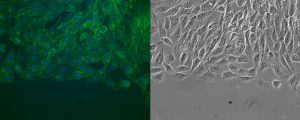New materials for nanomedicine
Cell magnetization for cell therapy
Magnetically assisted drug delivery
Hypertermia for cancer treatment
Principal investigators: Alessio Adamiano, Silvia Panseri, Monica Montesi, Monica Sandri
Personnel involved: Francesca Carella, Lorenzo Degli Esposti, Giada Bassi, Elisabetta Campodoni
Hydroxyapatite (HA, Ca5(PO4)3(OH)) is the main mineral component of bone. The flexible crystallographic structure renders HA very prone to accommodate foreign ions into its lattice, including magnetic ones. Fe, Gd, Dy and other elements can be used to confer magnetic properties to this otherwise diamagnetic material (i.e. not responsive to magnetic fields). In this respect, ISTEC Biomaterials’ group has developed a superparamagnetic nanomaterial referred to as FeHA, obtained by the substitution of Ca2+ ions with Fe2+ and Fe3+ in the HA lattice. FeHA nanoparticles were tested as smart multifunctional nanoplatforms for several application in the biomedical and nanomedicine fields.
For cell therapy. FeHA NPs uptake renders the cell with superparamagnetic features, which can be accurately guided to the target site by using an external magnetic field. Moreover, FeHA NPs, due to their unique features (i.e., HA structure, low Fe content, high degradation ratio), are fully biocompatible, bioresorbable and bioactive and they represent a new tool for cell therapy. Their non-specific adsorption on virtually any mammalian cells and their subsequent internalization by endocytosis pathway offers the feasibility to label a wide variety of cells with high efficiency.
For the drug delivery of bioactive molecules. FeHA nanoparticle have an high loading capacity compared to a large number of iron oxide nanoparticles commonly used in nanomedicine, preserving at the same time the intrinsic biocaompatibility and biodegradability of HA. Moreover, their high specific area and the wide variety of linking sites on their surfaces allows the functionalization of FeHA nanoparticles with a large number of molecules (e.g. DNA/RNA, miRNA, aptamers). This material is currently an object of research in the framework of an EU funded project entitled CUPIDO aiming to develop an unconventional and novel effective strategy for a non-invasive (via inhalation) nanoparticle-based delivery of therapeutic biomolecules to the diseased heart.
“magnetofection”, is a simple and highly efficient transfection method that uses magnetic fields to concentrate FeHA NPs containing nucleic acid into the target cells.
For magnetically assisted drug delivery and hyperthermia. FeHA can be loaded with several chemotherapeutic molecules, producing a nanosystem able to stop cancer cells growth and minimizing adverse side effects. Being endowed with superparamagnetic properties, FeHA can be used in innovative drug delivery approaches for the remote control of drug release by employing appropriate magnetic stimulus. Moreover, FeHA has the ability to generate heat when exposed to alternate magnetic fields (AMF). This ability called “hyperthermia” is typically displayed by magnetic materials and can be exploited in combination with conventional treatments (e.g. chemotherapy, radiotherapy, surgery etc.) to maximize the efficiency of cancer therapy.
Equipment and processes
- In vitro evaluation of novel magnetic biomaterials
- Cellular response to external magnetic fields.
- In vitro study of biomolecules controlled release
- Analysis of cell viability, morphology, proliferation, gene and protein expression (TimeLapse, Real Time PCR, Western Blot)
Main collaborations
- Istituto di Ricerca Genetica e Biomedica (IRGB-CNR).
- Centre Inter-universitaire de Recherche et d’Ingénierie des Matériaux – UMR CNRS.
- SPIN-CNR.
- Università Federico Secondo di Napoli.
- Humanitas Research Hospital (HRH).
- Università degli Studi di Milano.
